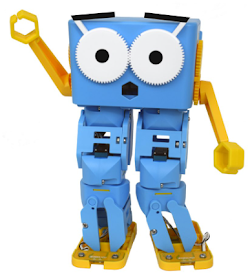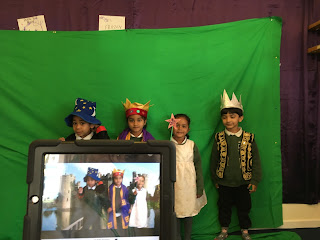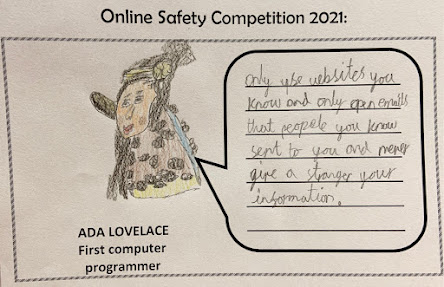A Review of my Day at Exabytes19
Welcome to my latest blog where I am going review my day at
the fantastic Exabytes19 conference. I considered doing a top 5 highlights for
this blog but it wouldn’t do it justice as I had more than 5 highlights!
I first came across Exabytes19 from Alan O’Donohoe
(@teknoteacher) who leads the Exa Foundation. Their mission is to ‘support
computing education and promote safe, secure and appropriate use of tech.’
(@ExaFoundation). Alan messaged me and asked if I would share on my twitter the
application form for presenting at ExaBytes. I shared the link and also successfully
applied. Exabytes19 is the ExaFoundation’s 4th annual conference.
Throughout the year they also run smaller training sessions around the country called
Exabits.
When I began to research previous Exabytes, I came across so
much positive feedback, with several people describing it as ‘the best CPD
training I’ve had all year’. I liked the idea that the conference wasn’t
enormous and there would only be under 100 people attending. This would make it
easier to network with others and not get lost in a huge crowd.
A few weeks before the event, Alan published a draft of the
breakout sessions that were available for delegates to attend. There were 5
slots in the day with 4 sessions going on simultaneously – I wish that human
cloning was a thing as I would have loved to have attended every single session
and it was so hard to just choose one from each time slot! Topics included
Microbit wearables, Scratch Maths, Game design, VR & AR, transitioning from
block coding to python, assessing ICT, code club activities, cardboard crafting
with tech and more! There were also keynotes from Sue Sentence on Computing
strategies and Hannah Dee on the awesomeness of Ada Lovelace.
The conference was at a lovely hotel in Northampton which
had great facilities and a fantastic choice of food for lunch! When I arrived,
I met some familiar faces; Nic Hughes (@duck_star) is part of the 3BM team who
run sessions for Brent Computing Leaders and 15 year old Josh Lowe (all_about_code)
and his dad David, who I had met at the LGfL conference this year, after Josh
introduced EduBlocks, an online resource he had created when he was 12 that
puts python code into a block coding format.
I also got two meet two great people who I had been
communicating with a lot recently on twitter; Andy Cowan (@Mr_C_ICT) and
Michelle Ainley (@computingmissa). Both are specialist ICT teachers so it was
great to hang out with people who actually had the same job as me! Something I
haven’t had since I was a class teacher, 3 years ago.
The conference began with the sad news that Sue Sentence was
unable to attend the conference for personal reasons, however this gave Hannah
Dee (@handee) more time to talk about Ada Lovelace, a computing pioneer who I
knew little about and was fascinated to learn about. From what Hannah told us,
it made me think how in awe Ada would be if she was alive today and saw how computing
had evolved over time. Hannah said she was the first computational thinker and
this was all before a computer had even be invented!
I then presented my seminar, a talk that I had presented
last year at the EduTech Show on ‘how to enrich the curriculum through image,
video and animation’. I was really pleased to have almost every seat in the room
filled – quite the opposite to the number of people I had at the EduTech show!
The presentation went really well and I got some good feedback from the
attendees. I hope they can take some of my ideas with them back to their
classrooms.
Afterwards, I attended Michelle Ainley’s talk on Scratch
Maths, this is a website of free resources that incorporates maths skills with
Scratch. It encourages a deeper level of thinking when working with algorithms
and shape and pattern work, and this was just the first lesson example that
Michelle showed us. We were given an activity where we had to write what would
be produced from a small list of block coding. The tricky part was, it was the
same blocks in each example but in a different order. The blocks would draw a
square but some had the same colour, some had different colours on each side
and some had different pen thickness. It all depended on the order of the
blocks and where they were in respect to the repeat loop. This was a great
activity and encouraged me to think hard and accurately understand the code I
was reading. I know I need to do more work with my children on getting them to
read code on paper and writing down what they think would be produced, rather than
just give them code and get them to press play to see what happens. I am going
to look into incorporating some Scratch Maths lessons into my Year 4, 5 and 6
coding curriculum next year.
After a delicious lunch with my new ICT specialist buddies
and Oli Howson (@ohowson), a lecturer of computing at The OU, I attended what
only felt like a creative D.T. lesson; making circuits out of primarily cardboard
and copper tape. This simple yet genius idea was run by Matt Moore
(@AlwaysComputing) who showed us examples of mazes, arcades games and a guitar
which were all made of cardboard and programmed using tools such as electrical
tape, insulated paint, copper tape, LEDs and buzzers. We then set about making
our own creations! I worked with Duncan Wakefield (@wakefielddunc), who
probably did most of the hard work, and we managed to create a simple switch
circuit that when connected, activated a small vibrator! (Note: Everyone in the
room was far too mature to find this remotely amusing!!!) A photo of Cardi-B is
shown below! Although I would love to introduce this into my curriculum, I
think I would need more practice and confidence with creating these kinds of
circuits before introducing it. It would more likely be introduced through an
after school club rather than into a year group’s lessons.
My penultimate session was a really good discussion of ideas
led by Sway Grantham (@SwayGrantham) on how to assess ICT. We began by taking
part in some polls to see how people currently assess and looked at people’s
opinions on what type of assessments they thought were most important. (e.g.
summative, formative etc…) We talked about the fact that there is not one solid
answer to the question ‘How do you assess ICT?’, but the best way to answer is
to share different ideas that will work for different areas of the curriculum.
For example, it might be teacher observations, a multiple choice Kahoot quiz, a
survey or using Diagnostic Questions. A technique that Sway uses is to use
questions to create a score and then this is transferred through a python
program to create a web grid. The nearer the child’s web is to the edge of the
grid – the closer they are to achieving in that area. In each corner of the
grid was a ‘Superhero’ computing area figure such as Code Captain, Net Ninja
and Hardware Hero. I really liked this idea as it clearly showed the areas of
computing that were a child’s strength and weakness. I will look into how I can
incorporate this type of recording into my assessments.
My last session before the end was an activity suggestion
for a code club. This was run by Cerys Lock (@RPi_Stuff) who showed us how to
create a rainbow using python code onto a Sense HAT Emulator (a micro
controller – a bit like a Microbit) Not sure if that is right, by the way – it
was all very new to me and I had never coded in python before! With the help of
Cerys, Michelle and Andy – I managed to just about get it done. We also
programmed it so it would disappear if the humidity and temperature controls
changed! Very cool stuff – however I think the closest that I’m going to get to
working with python in my school is by using EduBlock (@edu_blocks) with my
Year 6’s. I did enjoy the experience though!
We finally gathered together for closing words and had a reminder
from Holly Billinghurst (@TeachAllAboutIT) for us all to take time to
BREEEEEAAAAATHE and look after our well-being. I need to remember that
sometimes it’s ok to say… NO!
I was buzzing all the way home to London after the
conference. It was an absolute pleasure to present at Exabytes19 and I was
rewarded with a day of fantastic CPD and had met some brilliant people. The only downside was that I couldn't attend every seminar!!!
Thank you to Alan and his team for organising it and bring
on Exabytes20!!!
James Fraser (@EatSleepICTRpt)
















Comments
Post a Comment